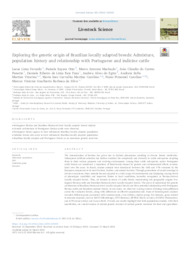Exploring the genetic origin of Brazilian locally adapted breeds: admixture, population history and relationship with Portuguese and indicine cattle.
Exploring the genetic origin of Brazilian locally adapted breeds: admixture, population history and relationship with Portuguese and indicine cattle.
Author(s): VERARDO, L. L.; OTTO, P. I.; MACHADO, M. A.; PANETTO, J. C. do C.; REIS, D. R. de L.; EGITO, A. A. do; VITORINO, A. S. M.; CAROLINO, M. I. C. M.; CAROLINO, N. P.; SILVA, M. V. G. B.
Summary: The domestication of bovines has given rise to distinct phenotypes resulting in diverse breeds worldwide. Subsequent artificial selection has further enriched the complexity and diversity to cattle sub-species adapting them to their various purposes and evolving environment. Among these cattle sub-species, native Portuguese cattle breeds are considered a repository of biodiversity shaped by genetic and environmental effects accumulated over the years. In Brazil, taurine animals were introduced between the 16th and 17th centuries by the European conquerors to be used for food, leather, and animal traction. Through generations of casual crossings in diverse ecosystems, these animals became adapted to a wide range of environments and displaying varying levels of phenotypic variability and improved fitness to local conditions, hereafter recognized as Iberian-derived Locally Adapted breeds. Thus, we focused in assess 13 cattle breeds representing two geographic origins: Portuguese Iberian cattle and Brazilian Iberian-derived Locally Adapted breeds. The aim is to understand the genetic architecture of Brazilian Iberian-derived Locally Adapted breeds and their potential relationship with Portuguese Iberian cattle and Brazilian indicine breeds. In our study, we observed varying extents of linkage disequilibrium across the evaluated breeds, along with differences in effective population size. Runs of homozygosity analyses revealed different genes associated with common traits, even within a cluster group. For instance, genes related to immune response, such as MAVS (Mertolenga), DTX (Barrosa), ˜ ZBTB16 (Brava de Lide), DUSP22 (Pantaneiro), and IL7R (Caracu Dairy and Caracu Beef). Overall, our results highlight that both populations studied, with their specificities, are crucial sources of animal genetic resource of animal genetic resources for food and agriculture.
Publication year: 2024
Types of publication: Journal article
Unit: Embrapa Dairy Cattle
Observation
Some of Embrapa's publications are published as ePub files. To read them, use or download one of the following free software options to your computer or mobile device. Android: Google Play Books; IOS: iBooks; Windows and Linux: Calibre.
Access other publications
Access the Agricultural Research Database (BDPA) to consult Embrapa's full library collection and records.
Visit Embrapa Bookstore to purchase books and other publications sold by Embrapa.

